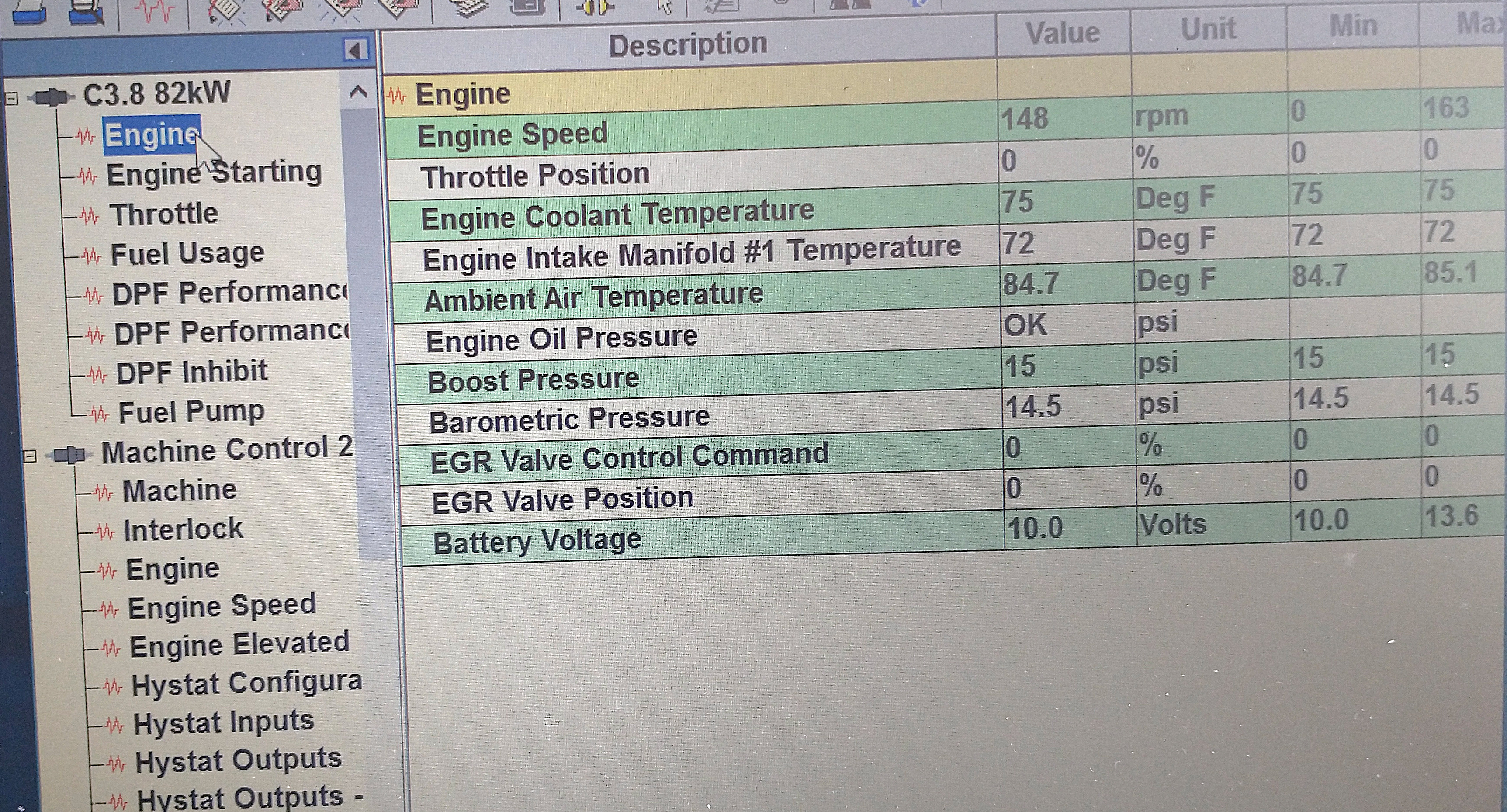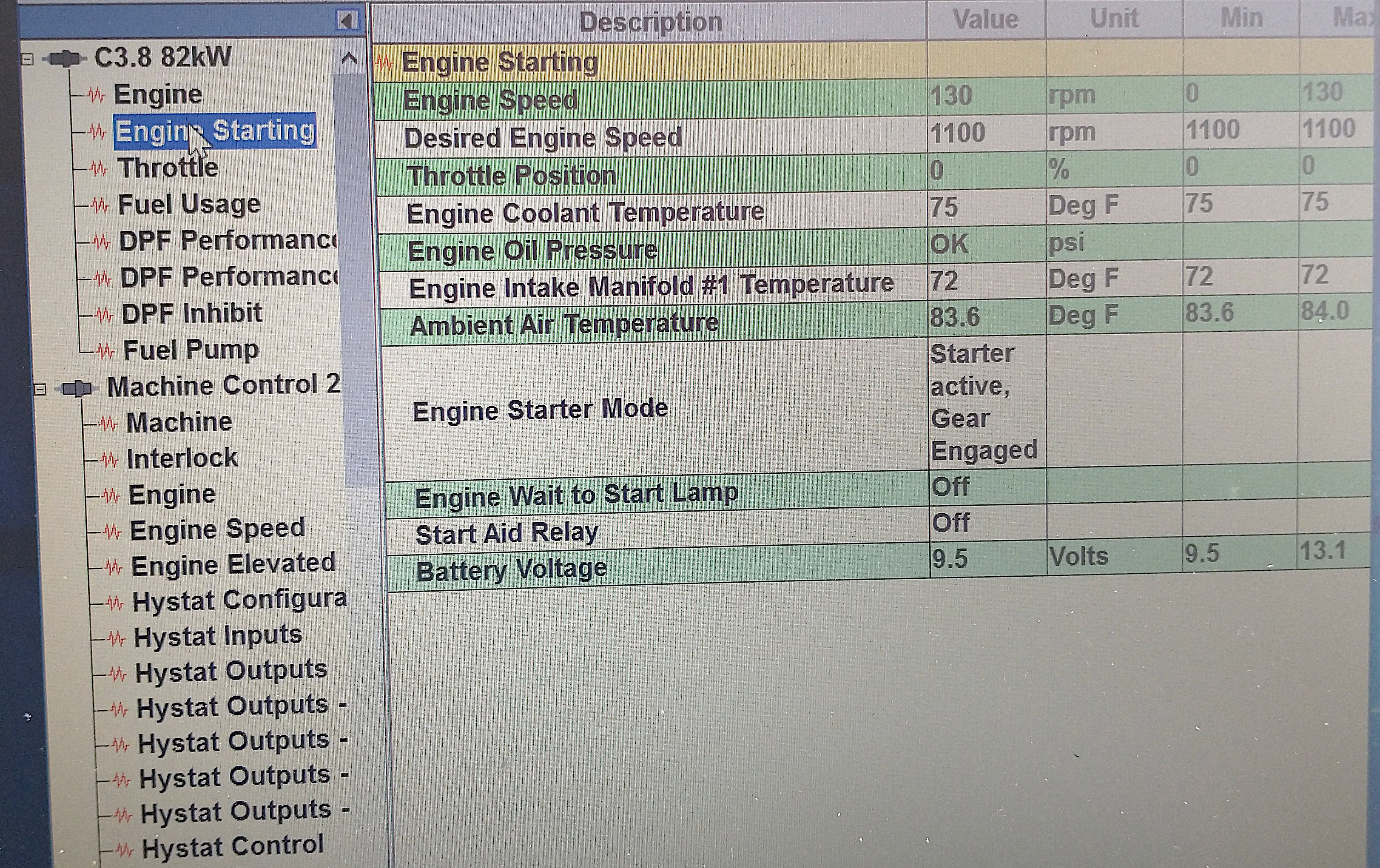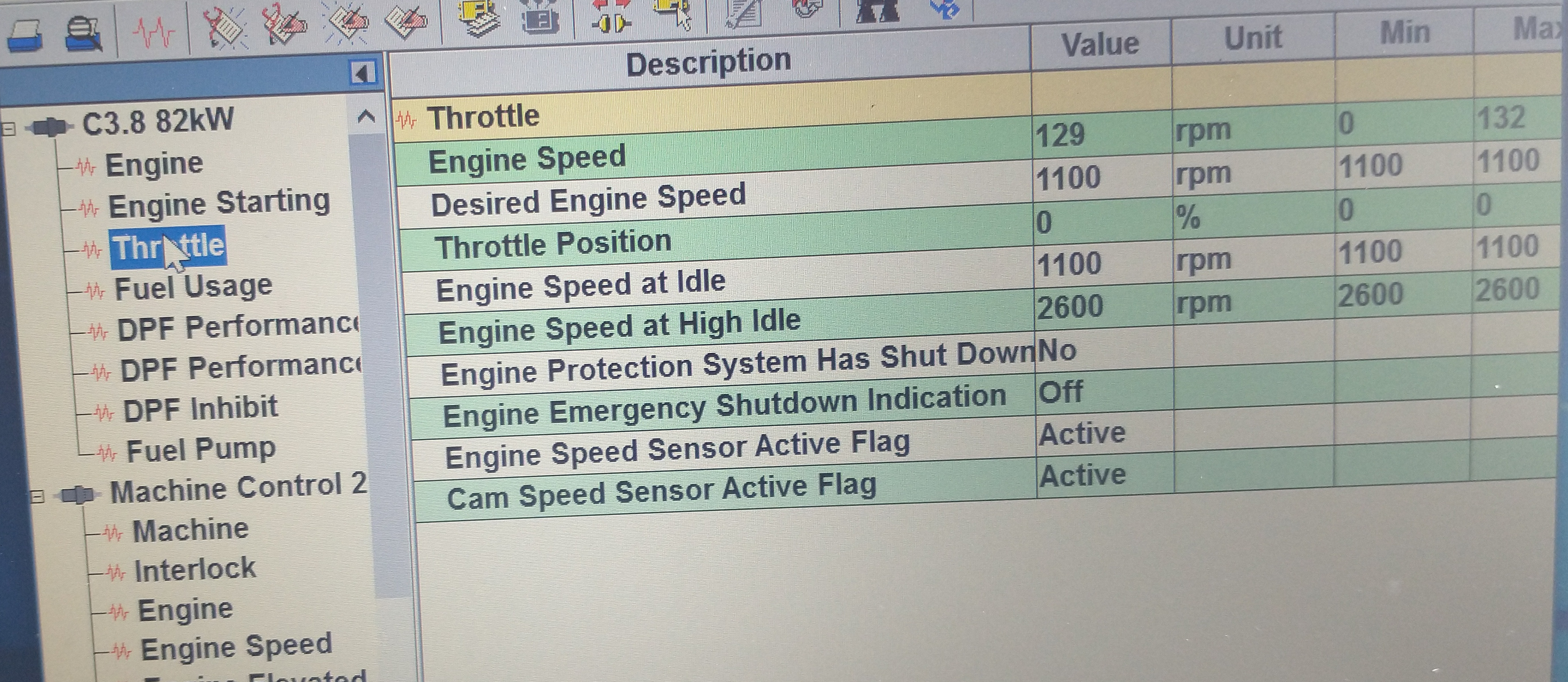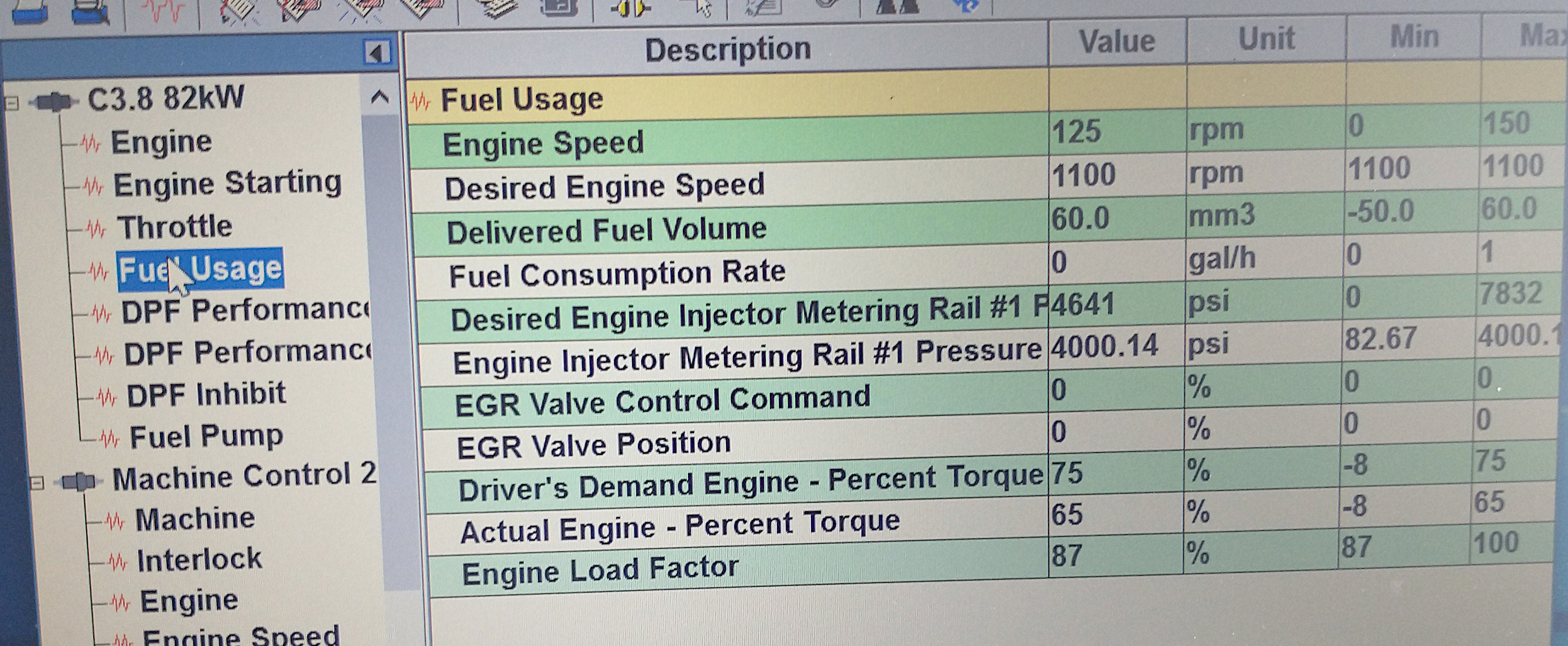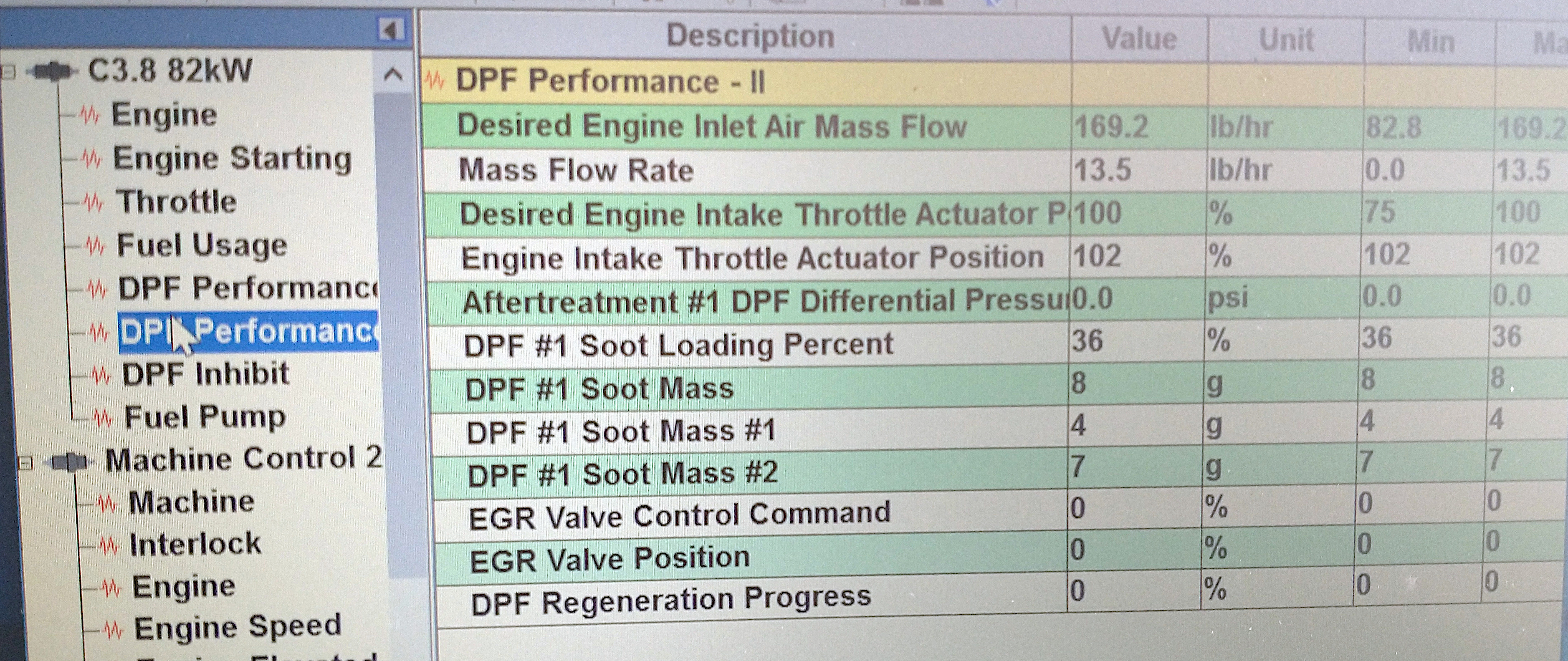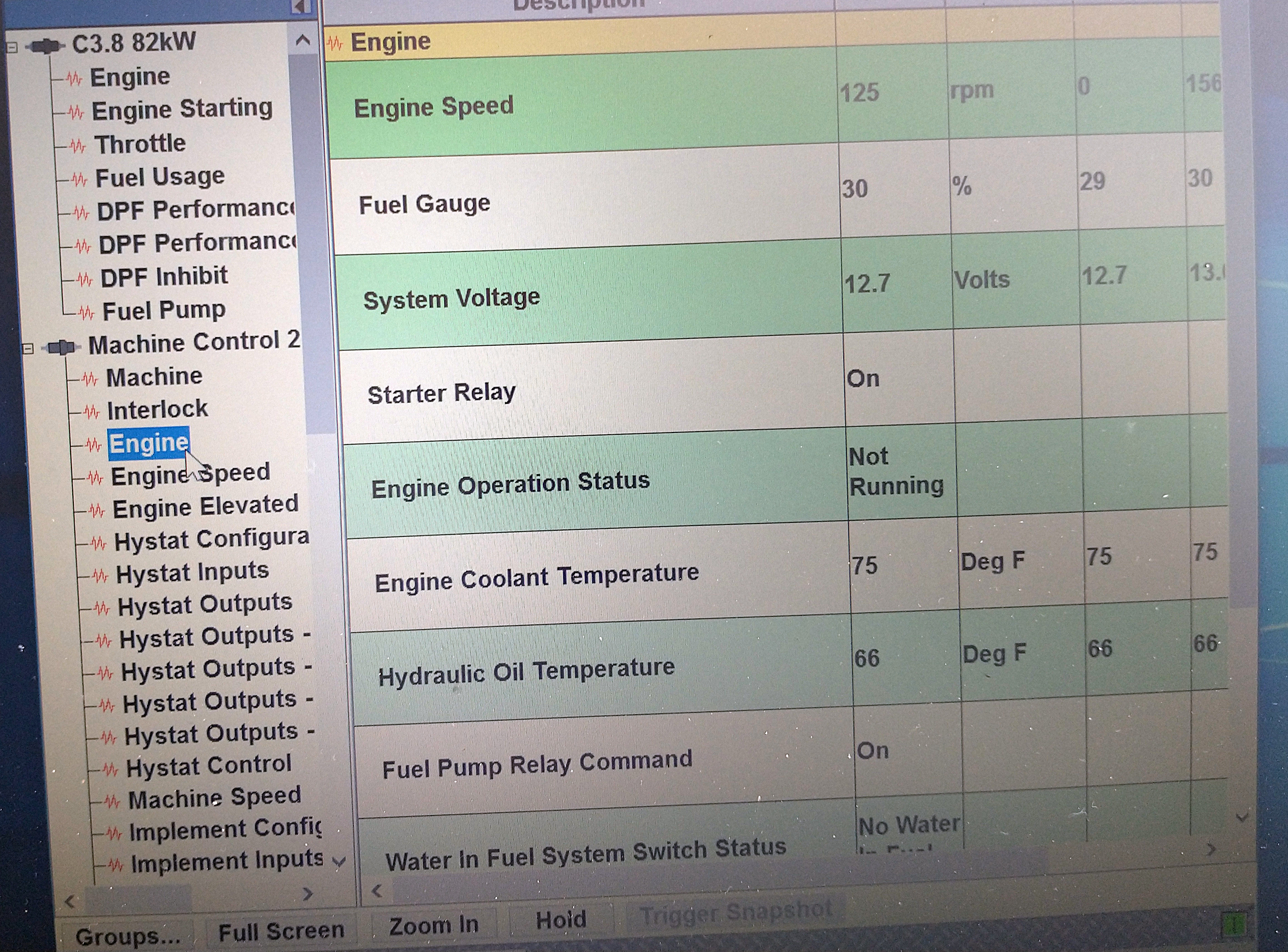-
Thank you for visiting HeavyEquipmentForums.com! Our objective is to provide industry professionals a place to gather to exchange questions, answers and ideas. We welcome you to register using the "Register" icon at the top of the page. We'd appreciate any help you can offer in spreading the word of our new site. The more members that join, the bigger resource for all to enjoy. Thank you!
You are using an out of date browser. It may not display this or other websites correctly.
You should upgrade or use an alternative browser.
You should upgrade or use an alternative browser.
Cat 299D2 Cranks, Won't start
- Thread starter david_
- Start date
Well against my better judgment, I tried again. This time I put a pipe wrench on the crank pulley and was finally able to crack that crank bolt.
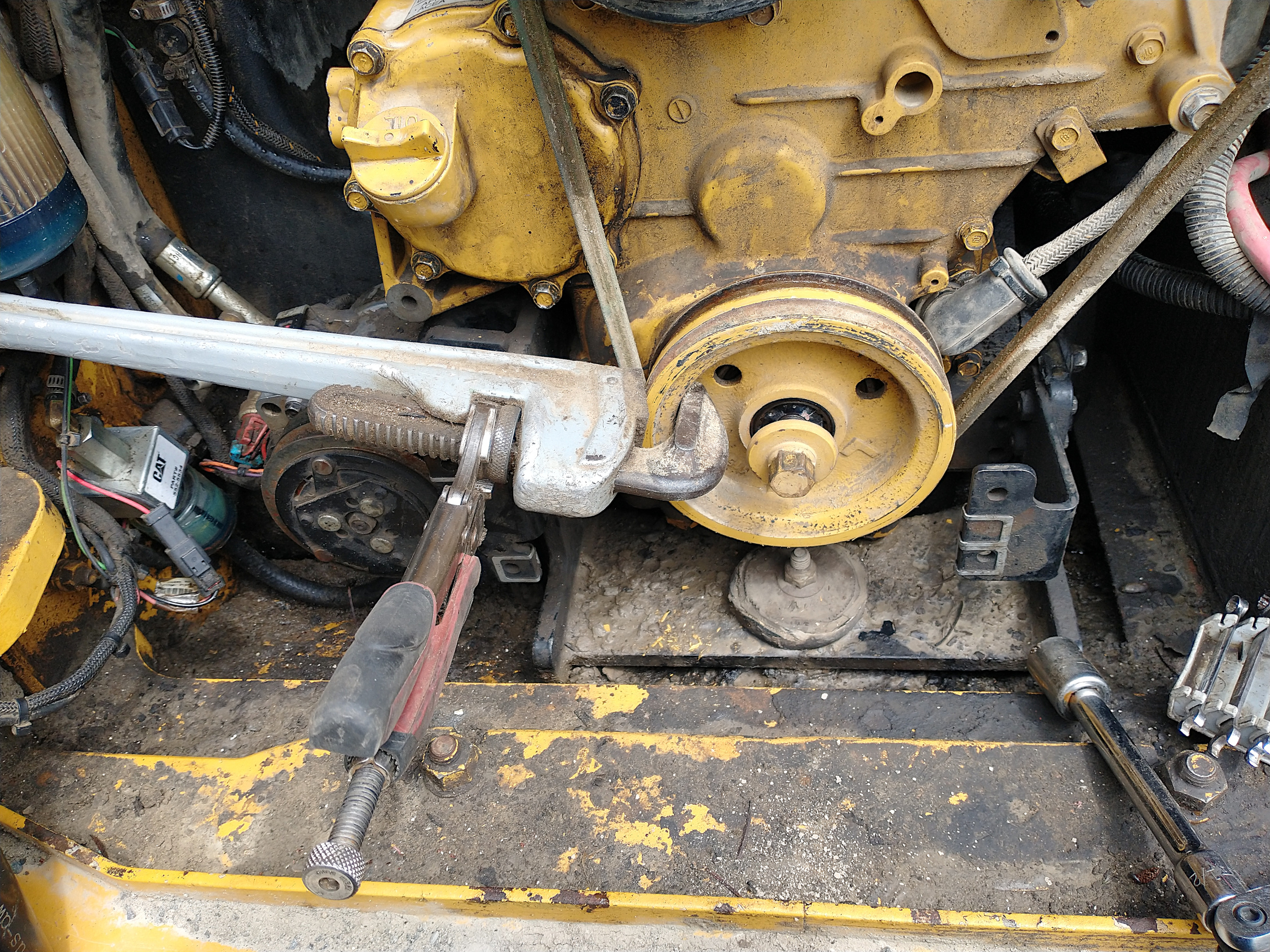
So I carefully pried off the timing cover. Care must be taken at the crank while removing as a bearing gear there is close.
The docs say to turn the crank CCW to set timing, and I'd assumed this is to allow for gear lash -- but this doesn't make sense. It's the crankshaft which drives everything and it turns CW. So I don't understand why docs say manually turn CCW for timing. Are they confused?
I found the mark on the crank gear and wiped the oil off, but the -mark- came off instead, just as with the fuel pump gear! Is this a kindergarten engine here? So I marked it with a Sharpie.
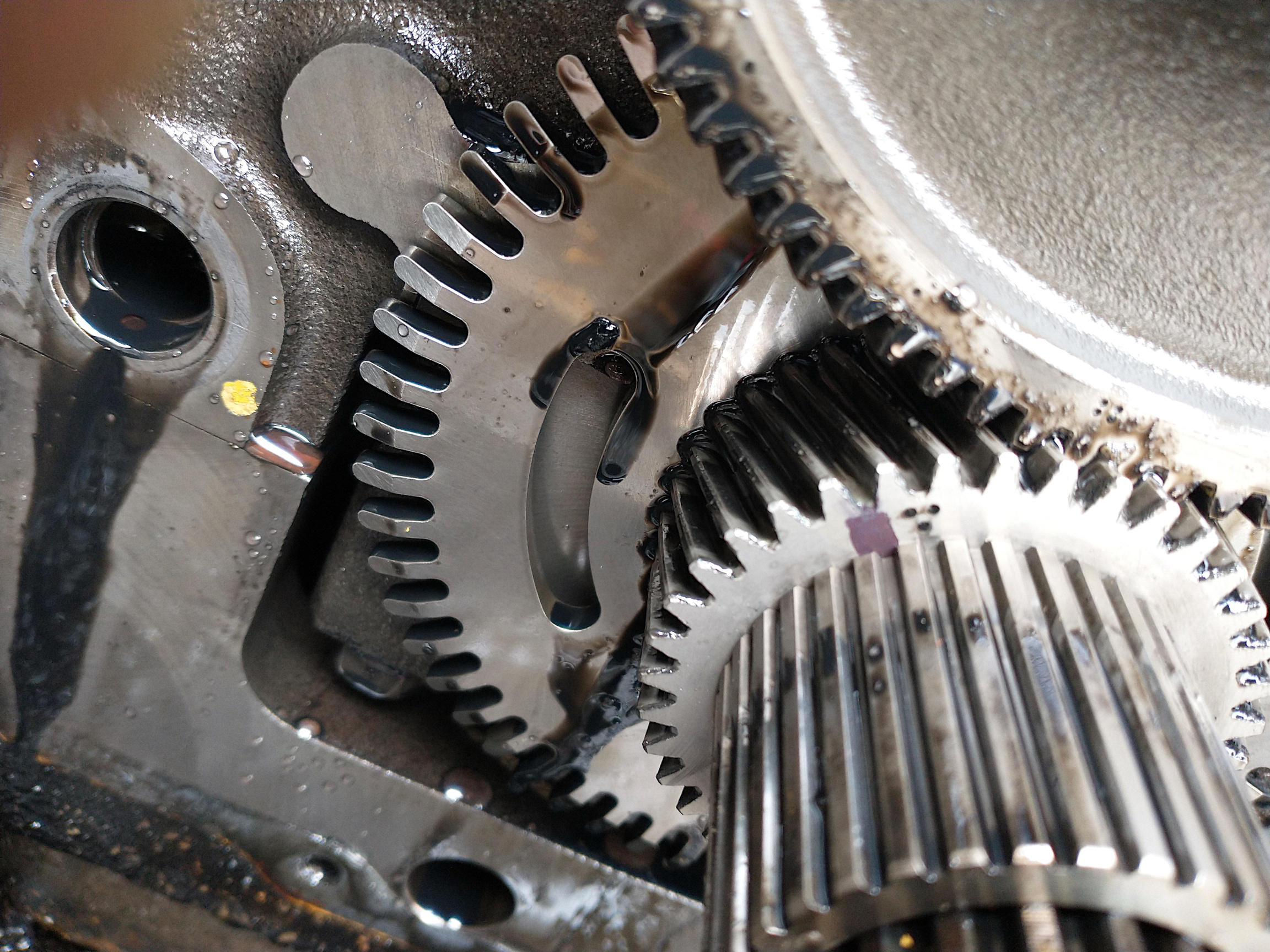
Now if you look carefully you'll notice three marks stamped in the gear in a triangle, one tooth away from the mark. Why wouldn't the stamped marks be TDC? Or is it?
Second thing you'll notice in this picture is how loose the crank teeth are in relation to the large idler. This is disturbing.
So I turned the crank CCW until the camshaft gear met the idler gear exactly, as in the drawing above. This is where the crank gear landed:

Yep, it's off. The cam and crank gear are both supposed to be right at the idler gear... but they are NOT. I couldn't believe it so I turned the crank for two more full rotations of the cam gear, and same result every time. This is where the crank gear ends up.
Where do I feel max compression? Here:
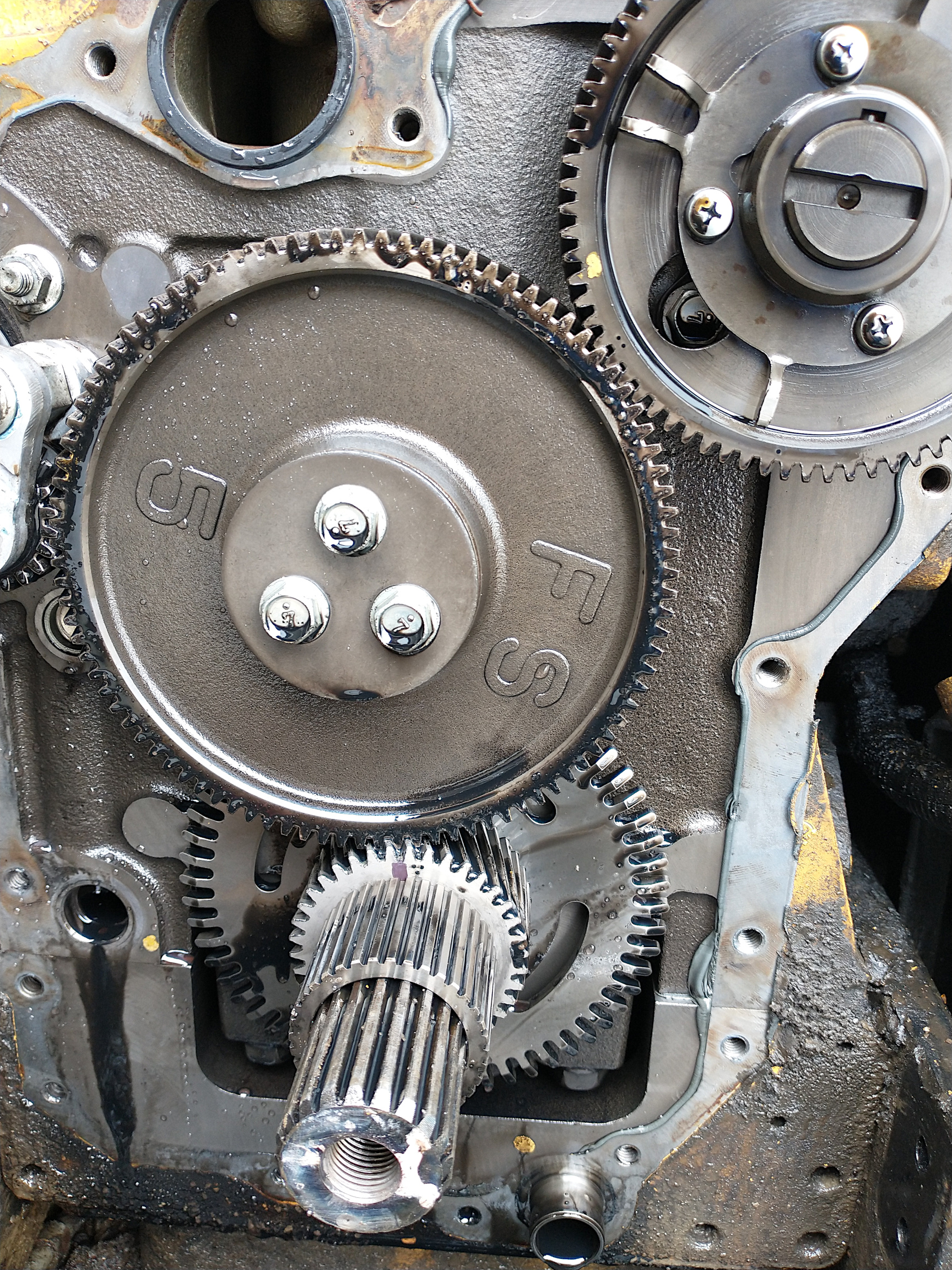
Right where the crank should be, whether for 1-4 or 2-3, but the cam gear is definitely OFF. Or -is- it? Zoom in on the picture and there are two stamped dots on the cam gear which line up correctly at this position. Are the yellow marks just bogus?
None of my pics captured the whole cam gear but it appears to have about 4x the number of teeth as the crank gear, which would make sense for a 4-stroke engine.
I suspicion at this point that when I went down the 1' ledge with a *bump*, the crank gear teeth slipped, and the engine instantly died. Looks to me like the large idler gear bearing is worn so it is loose?! It appears that the crank gear slipped about 4/5 of a revolution. This would also account for why it won't kick on ether. It would be a miracle if I haven't crashed valves.
How can a 2016 Cat have this kind of problem? Is the bearing/gear replaceable?
Have I crashed valves? Seems to me that I should have -two- compression points in the cam turning cycle, one for 1-4 at TDC and one for 2-3 180 degrees away. I notice only one compression point, where I've shown.
If I have crashed valves for 2-3, is there any sense replacing just them? Could the guides/seals be damaged as well? If so, is there an aftermarket source for rebuilt heads? Or would it be better to have this one rebuilt? I guess I could get valves/guides/seals, etc and provide to a machine shop.
Thoughts? Comments? Criticisms?

So I carefully pried off the timing cover. Care must be taken at the crank while removing as a bearing gear there is close.
The docs say to turn the crank CCW to set timing, and I'd assumed this is to allow for gear lash -- but this doesn't make sense. It's the crankshaft which drives everything and it turns CW. So I don't understand why docs say manually turn CCW for timing. Are they confused?
I found the mark on the crank gear and wiped the oil off, but the -mark- came off instead, just as with the fuel pump gear! Is this a kindergarten engine here? So I marked it with a Sharpie.

Now if you look carefully you'll notice three marks stamped in the gear in a triangle, one tooth away from the mark. Why wouldn't the stamped marks be TDC? Or is it?
Second thing you'll notice in this picture is how loose the crank teeth are in relation to the large idler. This is disturbing.
So I turned the crank CCW until the camshaft gear met the idler gear exactly, as in the drawing above. This is where the crank gear landed:

Yep, it's off. The cam and crank gear are both supposed to be right at the idler gear... but they are NOT. I couldn't believe it so I turned the crank for two more full rotations of the cam gear, and same result every time. This is where the crank gear ends up.
Where do I feel max compression? Here:

Right where the crank should be, whether for 1-4 or 2-3, but the cam gear is definitely OFF. Or -is- it? Zoom in on the picture and there are two stamped dots on the cam gear which line up correctly at this position. Are the yellow marks just bogus?
None of my pics captured the whole cam gear but it appears to have about 4x the number of teeth as the crank gear, which would make sense for a 4-stroke engine.
I suspicion at this point that when I went down the 1' ledge with a *bump*, the crank gear teeth slipped, and the engine instantly died. Looks to me like the large idler gear bearing is worn so it is loose?! It appears that the crank gear slipped about 4/5 of a revolution. This would also account for why it won't kick on ether. It would be a miracle if I haven't crashed valves.
How can a 2016 Cat have this kind of problem? Is the bearing/gear replaceable?
Have I crashed valves? Seems to me that I should have -two- compression points in the cam turning cycle, one for 1-4 at TDC and one for 2-3 180 degrees away. I notice only one compression point, where I've shown.
If I have crashed valves for 2-3, is there any sense replacing just them? Could the guides/seals be damaged as well? If so, is there an aftermarket source for rebuilt heads? Or would it be better to have this one rebuilt? I guess I could get valves/guides/seals, etc and provide to a machine shop.
Thoughts? Comments? Criticisms?
Last edited:
Ok, Reset.
It now looks like the gap I thought I saw between the crank and big idler was actually the crank gear had slid proud of the idler and there's no gap after all.
And I'm going to say that the paint dots are QC marks... not the timing marks. That the stamped engravings are the true marks. That's my decision and I've made up my mind.
When I had the crank at TDC, looking carefully at the cam gear its two stamped dots are in the correct position.
And I notice that the big idler also has stamped dots. I'll bet that when I remove and turn that idler, its dots will match those on the cam and crank when the timing is right.
So then it's a simply matter to set the fuel pump idler and gear, quick put the cover back on without sealing and try it. When it still fails order a new HPFP.
But this leaves open the question of why it would not kick on ether? And what is that other dot on the cam gear?
It now looks like the gap I thought I saw between the crank and big idler was actually the crank gear had slid proud of the idler and there's no gap after all.
And I'm going to say that the paint dots are QC marks... not the timing marks. That the stamped engravings are the true marks. That's my decision and I've made up my mind.
When I had the crank at TDC, looking carefully at the cam gear its two stamped dots are in the correct position.
And I notice that the big idler also has stamped dots. I'll bet that when I remove and turn that idler, its dots will match those on the cam and crank when the timing is right.
So then it's a simply matter to set the fuel pump idler and gear, quick put the cover back on without sealing and try it. When it still fails order a new HPFP.
But this leaves open the question of why it would not kick on ether? And what is that other dot on the cam gear?
And I'm going to say that the paint dots are QC marks... not the timing marks. That the stamped engravings are the true marks. That's my decision and I've made up my mind.
Correct.
The docs say to turn the crank CCW to set timing, and I'd assumed this is to allow for gear lash -- but this doesn't make sense. It's the crankshaft which drives everything and it turns CW. So I don't understand why docs say manually turn CCW for timing. Are they confused?
This was discussed earlier. Kubota apparently reference turning CCW from the flywheel end, which means CW at the pulley end. Not that it makes any difference for what you're doing.
Chrisso
Senior Member
BigWrench55
Senior Member
I'm not familiar with your engine, but I was looking at the data that you provided. And a few things jumped out at me. The engine rpm looks a bit slow while cranking. Your engine torque is at 65% and the load is at 87%. I would think that the rail pressure although lower than the desired pressure would start it if the engine was turning faster. I am wondering if you don't have a parasitic load on the engine from either the implement pump stroking up. Or the travel pump stroking up. I don't want to steer you in the wrong direction and hopefully someone more familiar with your engine could shine some light on this.
Cmark, I'll check. I'm pretty sure in the past the reading has responded to the dial.
Chrisso, did not do a Fuel Pump Calibration Override. Will study.
BigWrench the Aux solenoid is not working for some reason. (first image) I wonder if this is supposed to open for start, although that doesn't make sense as the Aux connections are closed on the arm. All solenoids are practically new, although there is a hydraulic leak at a connection above the solenoids which I haven't been able to fix. Don't understand "stroking up". Cranking the engine does indeed put a large strain on the battery, even when I'm jumping it from my SUV. While jumped with my SUV engine running, the voltage can go as low as 8. Seems very suspicious.
The engine died instantly when I went down a 1' ledge, and the back end got a thump.
Chrisso, did not do a Fuel Pump Calibration Override. Will study.
BigWrench the Aux solenoid is not working for some reason. (first image) I wonder if this is supposed to open for start, although that doesn't make sense as the Aux connections are closed on the arm. All solenoids are practically new, although there is a hydraulic leak at a connection above the solenoids which I haven't been able to fix. Don't understand "stroking up". Cranking the engine does indeed put a large strain on the battery, even when I'm jumping it from my SUV. While jumped with my SUV engine running, the voltage can go as low as 8. Seems very suspicious.
The engine died instantly when I went down a 1' ledge, and the back end got a thump.
Last edited:
BigWrench55
Senior Member
The pumps in your machine are axial piston pumps. They have a swash plate that is controlled by what is called compensator valve. If the valve has failed or for some other reason it is receiving load sense. Then the swash plate is moved to the full stroke position (stroking up). If this is the case then one of your pumps is putting out full flow. Thus you have a parasitic load and the the starter can't overcome the load to spin the engine fast enough. Like I said this is something that I observed through your data. I don't know enough about your machine to be certain. But the voltage drop you described on top of the data. Makes me lean towards my observation. I hope that someone more knowledgeable of your machine will clear this up. I don't want for you to chase ghost on my account.
Chrisso
Senior Member
David, next time you have ET hooked up, go to Diagnostics > Diagnostic Tests. Under your engine ECM you'll see an "override parameters" section. Tell me what's in there. The SIS procedures are vague but seem to suggest there's a fuel pump calibration "overide" function that needs to be done. I'm thinking you may need to "override" these parameters to get it running, then follow a calibration procedure once it is running... possibly.Chrisso, did not do a Fuel Pump Calibration Override. Will study.
I always thought engine load factor while cranking should be 100%. At least that's what I've found a few times on other perfectly running engines. Load factor is just a calculation made by the ECM (actual fuel used divided by max theoretical fuel it can use for that particular condition). In reality I've seen load factors on cranking engines all over the place. I usually pay more attention to them when the engine is running.Your engine torque is at 65% and the load is at 87%.
I'm by no means saying there's not potentially a parasitic load on this engine, there could be, I just think we need more evidence...
Which brings me to cranking speed... needs to be at least 120 RPM while cranking on a new engine. Engines with higher hours (and less compression) need more, say 130 RPM or so. Battery voltage while cranking... needs to be at least 9 - 9.5 volts to keep power to the ECMs. Below this gets dicey. 10v is perfect. Now's the time to make sure that battery is perfectly charged.
Last edited:
BigWrench55
Senior Member
David, next time you have ET hooked up, go to Diagnostics > Diagnostic Tests. Under your engine ECM you'll see an "override parameters" section. Tell me what's in there. The SIS procedures are vague but seem to suggest there's a fuel pump calibration "overide" function that needs to be done. I'm thinking you may need to "override" these parameters to get it running, then follow a calibration procedure once it is running... possibly.
I always thought engine load factor while cranking should be 100%. At least that's what I've found a few times on other perfectly running engines. Since load factor is just a calculation made by the ECM (actual fuel used divided by max theoretical fuel it can use for that particular condition). In reality I've seen load factors on cranking engines all over the place. I usually pay more attention to them when the engine is running.
I'm by no means saying there's not potentially a parasitic load on this engine, there could be, I just think we need more evidence...
Which brings me to cranking speed... needs to be at least 120 RPM while cranking on a new engine. Engines with higher hours (and less compression) need more, say 130 RPM or so. Battery voltage while cranking... needs to be at least 9 - 9.5 volts to keep power to the ECMs. Below this gets dicey. 10v is perfect. Now's the time to make sure that battery is perfectly charged.
That's the feedback that I was hoping to get. When it comes to machines that I work on the most. I am more familiar with those idiosyncrasies and would know if it was normal or not. I didn't want to have Dave chasing after bad information.
Cmark, the throttle position % does respond to the dial in E.T., from 0% to 100%.
Chrisso, I couldn't find anything in UENR3423-22 about a fuel pump calibration override, even though it's referred to in the fuel pump install instructions.
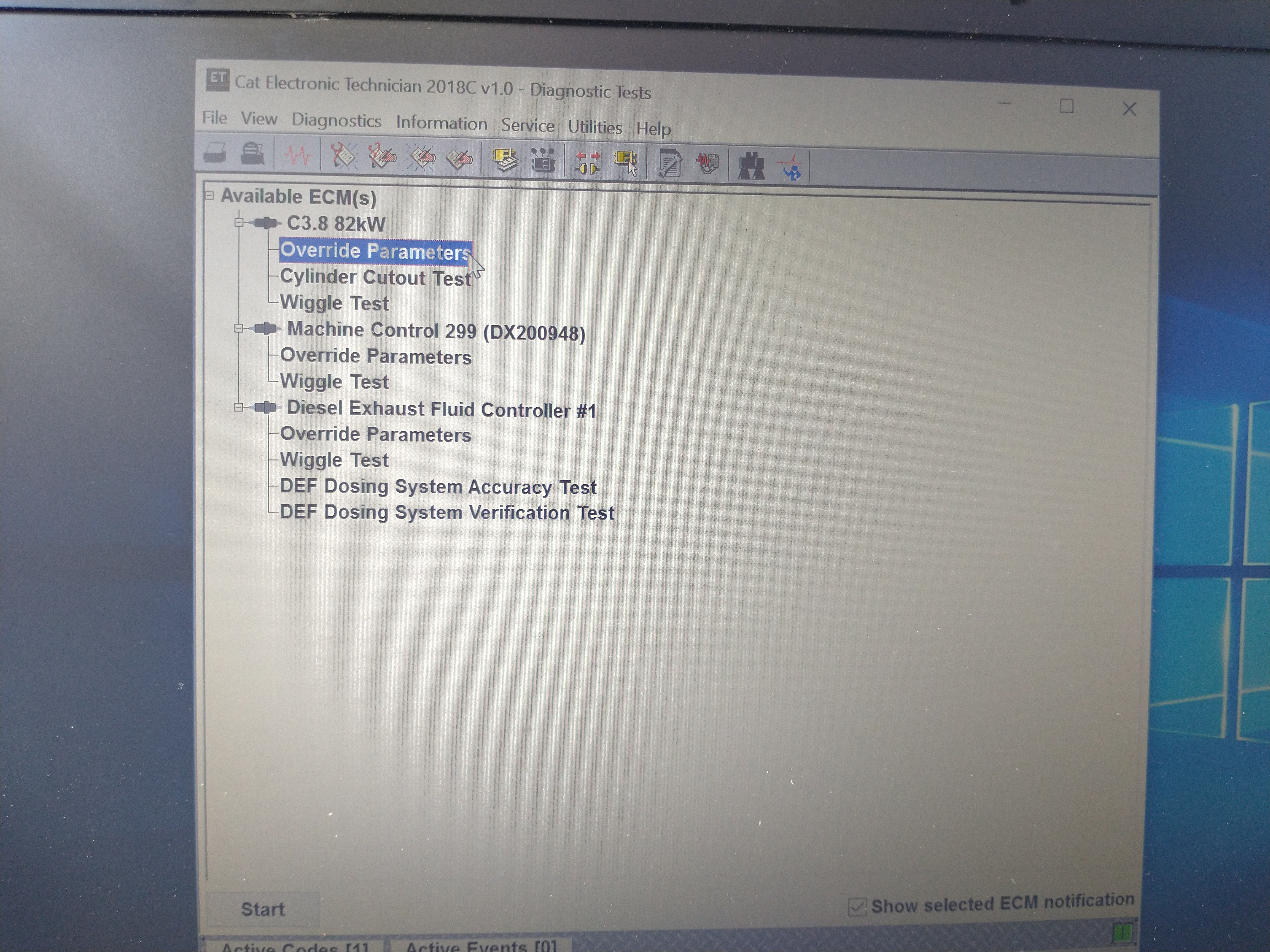
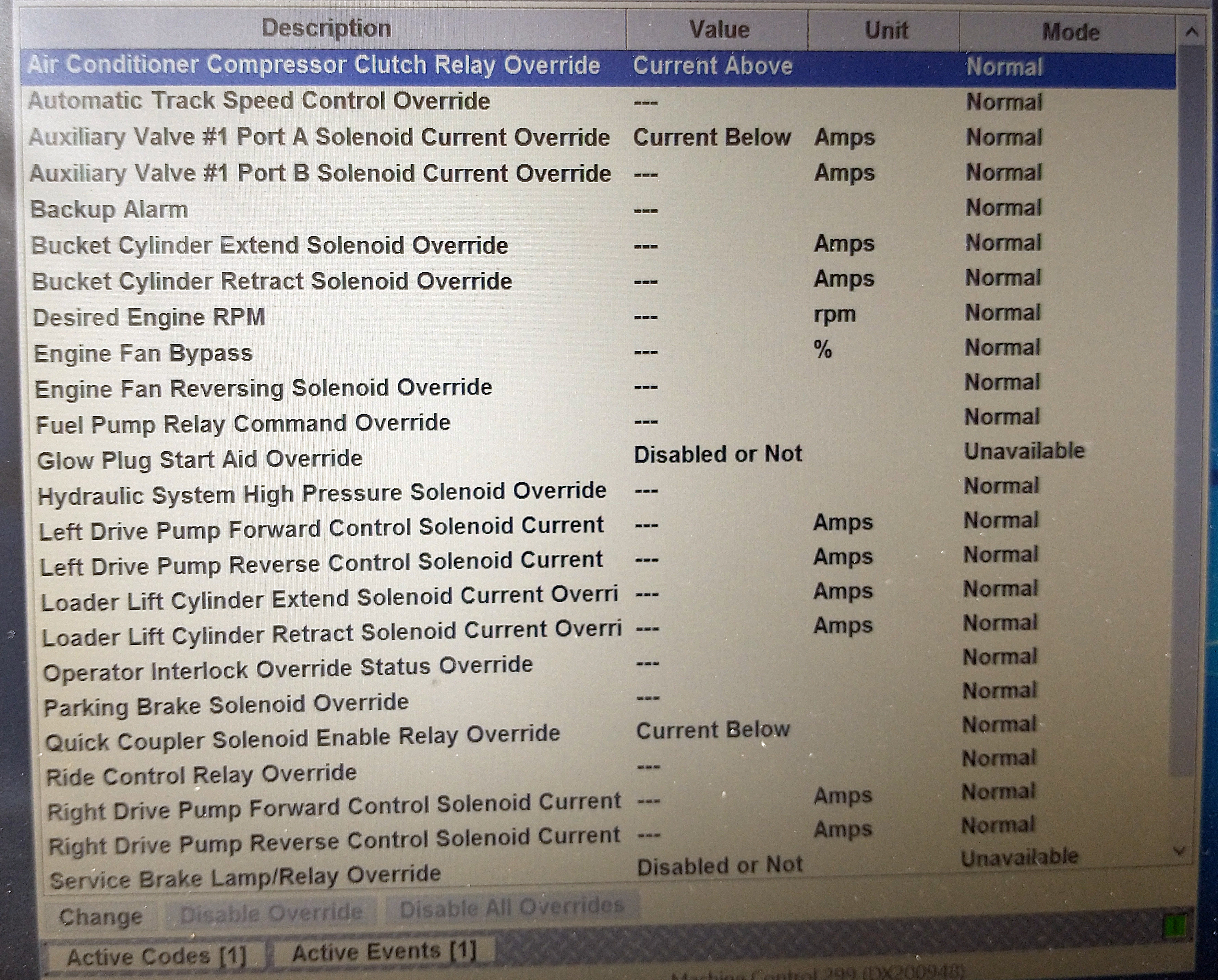

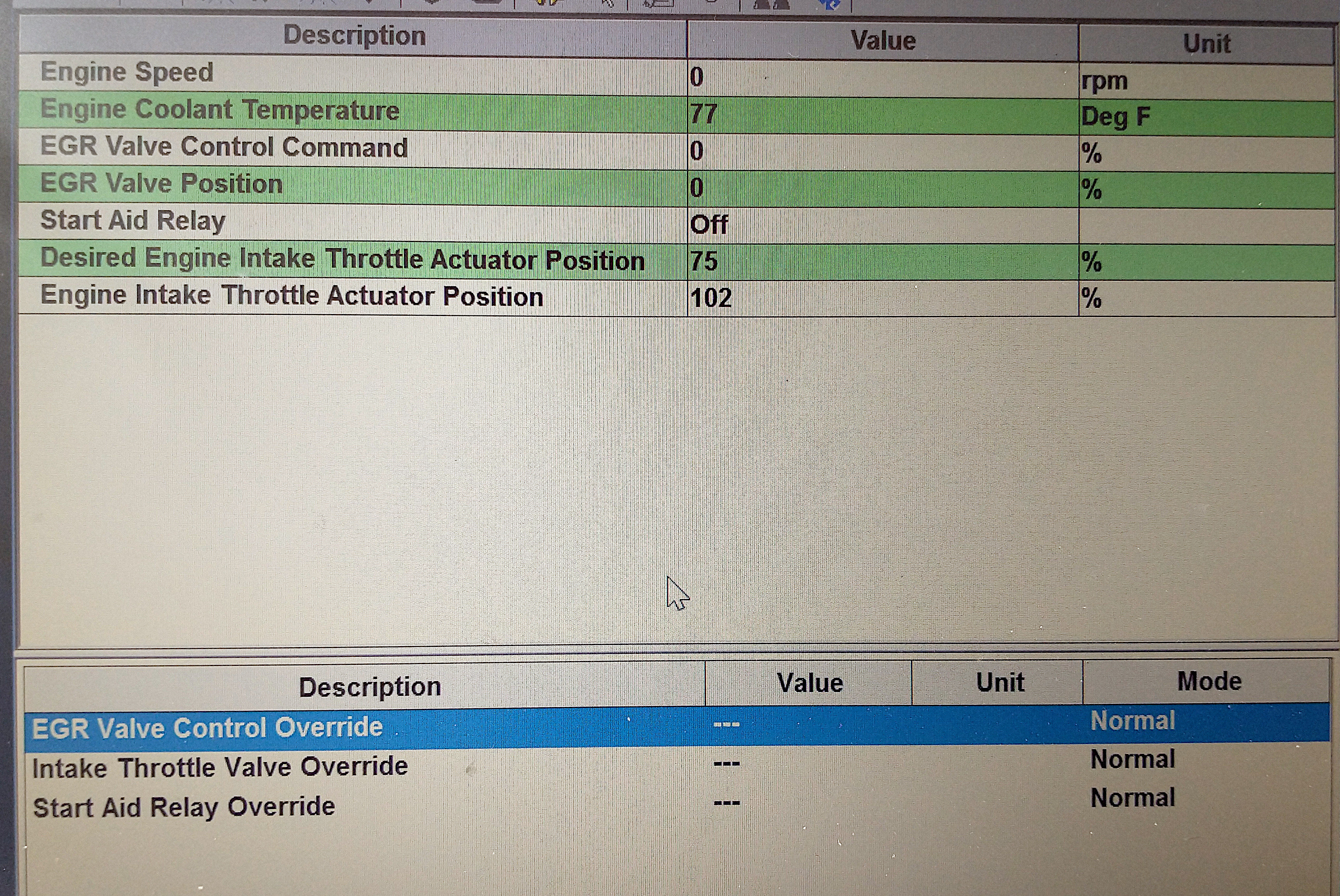
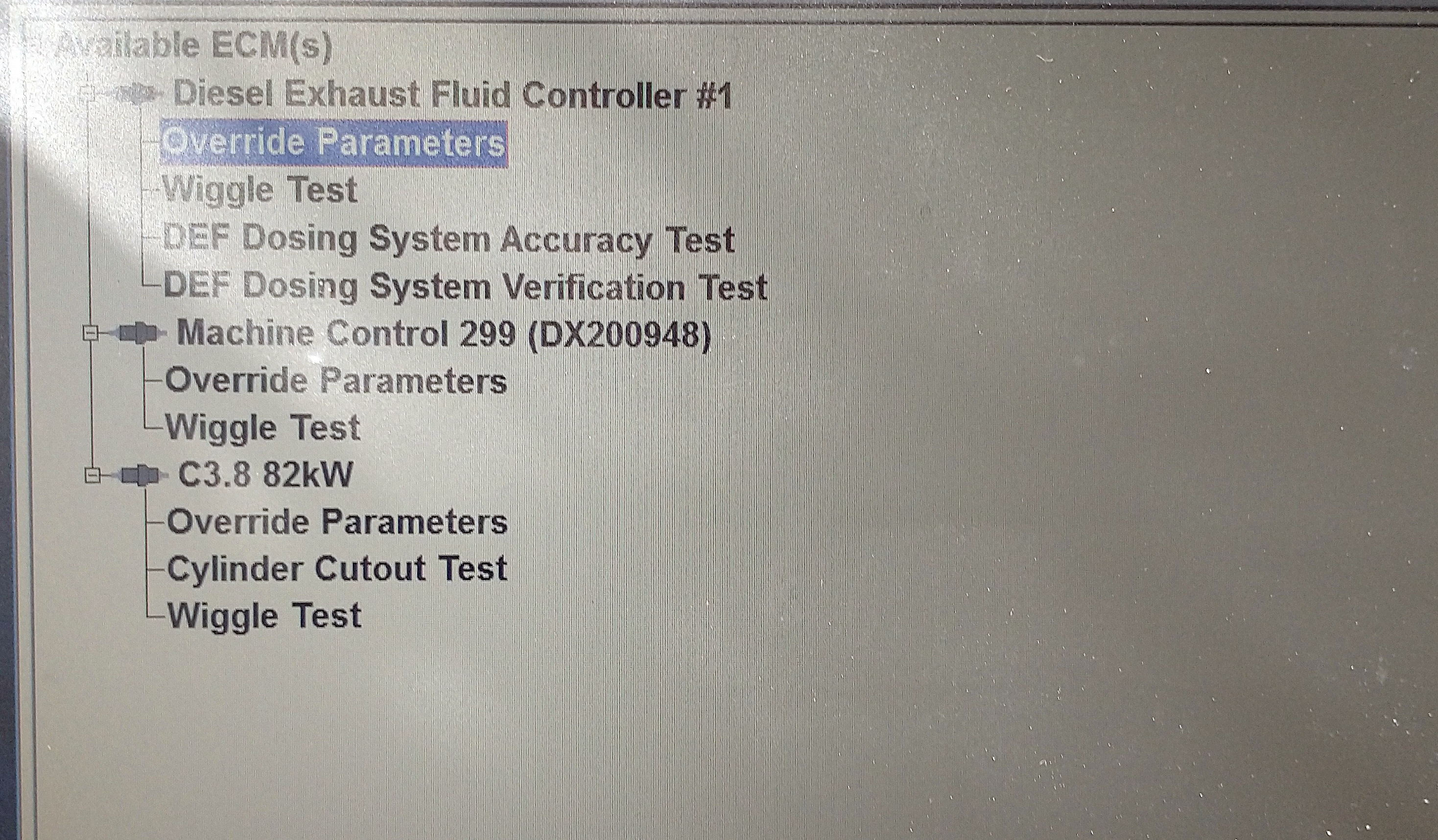
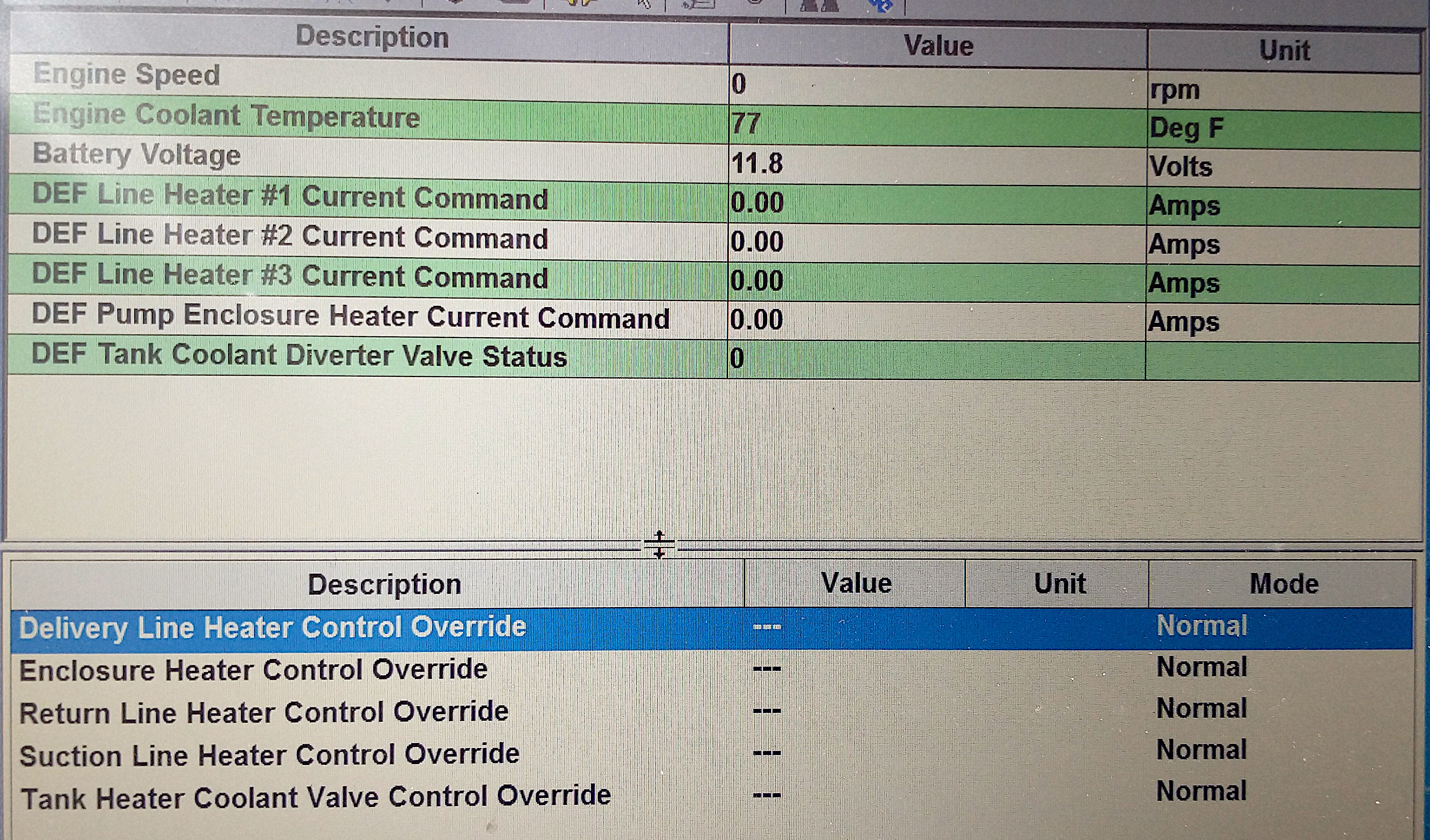
Well it looks like I've accidentally deleted the engine override paramerters, but it was only three items, none to do with the fuel pump.
Chrisso, I couldn't find anything in UENR3423-22 about a fuel pump calibration override, even though it's referred to in the fuel pump install instructions.






Well it looks like I've accidentally deleted the engine override paramerters, but it was only three items, none to do with the fuel pump.
Chrisso
Senior Member
This is slightly concerning...

because this should generate a new diagnostic code if the engine ECM can't rectify this after a certain period of time, so I would definitely try to override these parameters. Here's a thought, override it from 0% to 100% and make sure you can hear it actuate. From what I understand, 100% means wide open. I would also try the same thing with the EGR control. For reference, here's a screenshot taken from a 299D3 at low idle, operating temp. Note the 25% throttle position and 14% EGR valve. But more importantly, desired values equal actual values.

My gut feeling is still injector leakage on this, and I remember saying it's not uncommon to replace pump, rail & injectors on these in that order. Add to that list an ECM. But here's the thing... generally a dealer wouldn't go that far without some sort of consultation with their Technical Communicator, which is the person who talks to the Cat engineers... hence from here on the mechanic would be acting under guidance from Cat engineers, which is a good thing.
Failing my abovementioned checks, I really think your only options here are to take another gamble and replace all 4 injectors (which you're going to need a dealer version of ET to program the injector codes) or take it to another dealer.
The first thing a dealer needs to do is upgrade your software.
because this should generate a new diagnostic code if the engine ECM can't rectify this after a certain period of time, so I would definitely try to override these parameters. Here's a thought, override it from 0% to 100% and make sure you can hear it actuate. From what I understand, 100% means wide open. I would also try the same thing with the EGR control. For reference, here's a screenshot taken from a 299D3 at low idle, operating temp. Note the 25% throttle position and 14% EGR valve. But more importantly, desired values equal actual values.
My gut feeling is still injector leakage on this, and I remember saying it's not uncommon to replace pump, rail & injectors on these in that order. Add to that list an ECM. But here's the thing... generally a dealer wouldn't go that far without some sort of consultation with their Technical Communicator, which is the person who talks to the Cat engineers... hence from here on the mechanic would be acting under guidance from Cat engineers, which is a good thing.
Failing my abovementioned checks, I really think your only options here are to take another gamble and replace all 4 injectors (which you're going to need a dealer version of ET to program the injector codes) or take it to another dealer.
The first thing a dealer needs to do is upgrade your software.
This is slightly concerning...
View attachment 263928
because this should generate a new diagnostic code if the engine ECM can't rectify this after a certain period of time, so I would definitely try to override these parameters. Here's a thought, override it from 0% to 100% and make sure you can hear it actuate. From what I understand, 100% means wide open. I would also try the same thing with the EGR control. For reference, here's a screenshot taken from a 299D3 at low idle, operating temp. Note the 25% throttle position and 14% EGR valve. But more importantly, desired values equal actual values.
View attachment 263929
My gut feeling is still injector leakage on this, and I remember saying it's not uncommon to replace pump, rail & injectors on these in that order. Add to that list an ECM. But here's the thing... generally a dealer wouldn't go that far without some sort of consultation with their Technical Communicator, which is the person who talks to the Cat engineers... hence from here on the mechanic would be acting under guidance from Cat engineers, which is a good thing.
Failing my abovementioned checks, I really think your only options here are to take another gamble and replace all 4 injectors (which you're going to need a dealer version of ET to program the injector codes) or take it to another dealer.
The first thing a dealer needs to do is upgrade your software.
What do you think of the fact that it won't even fire on ether? That's what's confusing me.
david_. How does it sound when cranking? Even, regular beats? Something else?
Chrisso
Senior Member
I figured the intake throttle must be closed, which is pretty normal if start conditions aren't met.What do you think of the fact that it won't even fire on ether? That's what's confusing me.
But I am thinking a compression test will have to be done sooner or later... as well as a valve set & visual inspection of the rocker gear while cranking engine by hand.
Thing that's got me beat is rail pressure. Desired should equal very very close to actual, even during crank. but we're still 640 psi out.
Last edited:


